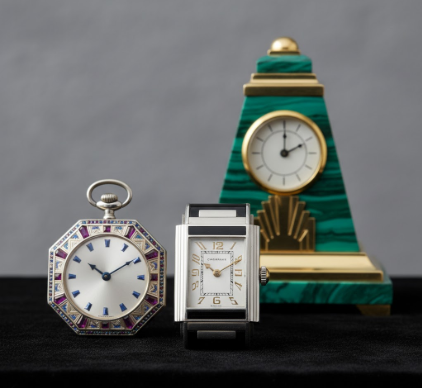The 1920s, an era often romanticized as the Roaring Twenties, was a decade of profound social, artistic, and technological change. Emerging from the shadows of the Great War, society hurtled into a new age of optimism, speed, and modernity. This exuberant spirit found its ultimate visual expression in a design movement that would come to define the era:
Art Deco. A symphony of sharp lines, bold geometry, and luxurious glamour, Art Deco touched everything from skyscrapers to furniture, and nowhere was its influence more elegantly captured than in the design of the newly fashionable wristwatch.
Before the 1920s, the personal timepiece was predominantly a pocket watch, a gentleman’s accessory tucked away from sight. The wristwatch was considered somewhat effeminate or a novelty. World War I changed everything. Soldiers needed to synchronize attacks and check the time quickly without fumbling for a watch in their pockets. The practical necessity of the ‘trench watch’ cemented its place on the wrist, and by the time the war ended, it had shed its purely utilitarian image and was poised to become a canvas for artistic expression.
The Geometry of a New Age
Art Deco was, at its core, a celebration of the machine age and a rejection of the flowing, nature-inspired forms of the Art Nouveau period that preceded it. It embraced symmetry, clean lines, and geometric shapes—circles, squares, rectangles, triangles, and octagons. This design language was perfectly suited to the compact and functional nature of a watch case. Watchmakers enthusiastically abandoned the traditional round case that had dominated for centuries and began experimenting with a dazzling array of new forms.
The rectangular case became an icon of the era, most famously embodied by the
Cartier Tank, introduced in 1917 but reaching peak popularity in the 20s. Its design, inspired by the top-down view of a military tank, was a masterclass in clean, parallel lines. Other popular shapes included the tonneau (barrel shape), the cushion case with its softened corners, and the daring octagonal case. These weren’t just watches anymore; they were miniature sculptures for the wrist, reflecting the architectural dynamism of new city skylines filled with ziggurat-topped skyscrapers like the Chrysler Building.
Materials and Dials: A Modernist Palette
The materials used also shifted to reflect this new modern aesthetic. While yellow gold was still used, the cool, sleek tones of platinum and white gold became the metals of choice, often complemented by the industrial look of stainless steel. This palette created a perfect backdrop for the bold accents that characterized Art Deco decoration.
Watch dials underwent a radical simplification. Ornate, fussy dials were replaced with clean, often silvered or stark white surfaces that prioritized legibility and graphic impact. A popular design was the sector dial, which used concentric circles and lines to divide the face into zones, creating a sense of order and precision. The numerals themselves were perhaps the most telling feature. The delicate Roman or flowing Breguet numerals of the past were cast aside for highly stylized, geometric Arabic numerals. These new fonts were bold, elongated, and sometimes ‘exploding’ in a sunburst pattern from the center of the dial, full of energy and forward momentum. In some cases, numerals were done away with entirely in favor of simple baton markers or dots, pushing the design towards pure abstraction.
Art Deco gets its name from the 1925 Exposition Internationale des Arts Décoratifs et Industriels Modernes held in Paris. This world’s fair was a massive showcase of this new style in architecture, interior design, fashion, and jewelry. The movement did not have a unified name until this event crystallized its identity for the world.
From Case to Bracelet: A Unified Design
The Art Deco philosophy demanded a holistic design where every element was in harmony. This meant the strap or bracelet was no longer an afterthought but an integral part of the watch’s overall aesthetic. Leather straps remained popular, but metal bracelets with intricate geometric links became a hallmark of the period’s finest timepieces. These bracelets often continued the lines and motifs of the case, creating a seamless flow around the wrist.
For high-end ladies’ watches, which were often worn as fine jewelry, this integration was even more pronounced. Cases were frequently adorned with precious stones like diamonds, sapphires, and emeralds, set in geometric patterns. The bezels might feature intricate milgrain detailing or be inlaid with contrasting materials like black onyx or vibrant lapis lazuli. The watch became a singular piece of jewelry, a testament to the craftsmanship and artistic vision of the era.
Enduring Icons and a Lasting Legacy
Several timepieces from this period have become enduring icons, proving the timeless appeal of Art Deco design. The aforementioned Cartier Tank and the
Jaeger-LeCoultre Reverso, with its ingenious reversible case designed for polo players in 1931, are perhaps the most famous. These watches are still in production today, their designs largely unchanged, a testament to their perfect fusion of form and function. They represent the pinnacle of an era when a watch was more than just a tool for telling time—it was a bold declaration of style, a symbol of progress, and a piece of wearable art.
The influence of Art Deco on watch design is undeniable and everlasting. It established a new vocabulary of shapes, a new approach to graphic design on the dial, and a new understanding of the watch as an object of fashion and personal expression. While styles have come and gone, the core principles of Art Deco—its love for clean lines, its respect for symmetry, and its unapologetic boldness—continue to inspire watchmakers today. It was a brief but brilliant moment in time when the ticking of a watch on a wrist beat in perfect rhythm with the roaring pulse of a new, modern world.









